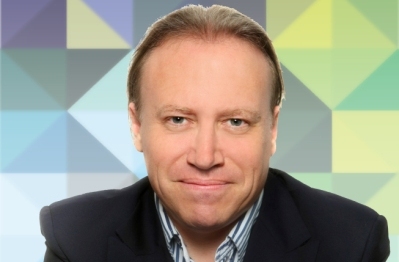
To Paul Strong, VMware CTO and a British-born, Silicon Valley based technologist, a history of the IT world looks something like this: for 30 years apps were monolithic; then they started to appear on PCs; then, with the development of the LAN and sharing files, we ended up at the client-server.
"At an enterprise level, this has brought us to a world of complexity," he says. "So the next stage must be to determine the cost of simplicity."
"In the legacy days of IT – say, going back 20-25 years – the job of tech was to optimise the process, to make the process repeatable and reliable. But when it came to looking at the data these digital systems produced it was a very manual process. It was what Strong calls "none-machine computing at a human scale".
Strong believes is that the age of using data to build new business models and to radically change existing companies is finally here.
We’ve been promised this before but the combination standardised and simplified infrastructure means we’re at the inflection point.
The App, Infrastructure and Network stack
He says: "First off, the traditional cost of corporate service delivery is 85% people and software – the underlying infrastructure doesn’t cost that much."
However, due to there being complexities in all layers of the stack, it is extremely difficult to get scale.
Strong explains: "Because a typical corporate is running thousands of apps, you need people to install, monitor and support those apps. That is expensive and difficult to scale.
With regard to applications Strong accepts within the enterprise space we are at the beginning of the adoption curve for application simplification.
"We are in some ways at the early stage, but to find cost savings for general-purpose applications such as CRM or other packaged applications it is the provider of services who will be cheaper and they will be able to provide a better service," he says. "The customer may say ‘I can deliver cheaper,’ but ultimately they won’t be able to. Certainly, one can see it with SaaS. It is about simplification and the cost of simplification."
He offers an example. An executive he knows recently joined a company and embarked on a strategy of ruthless simplification. Within his traditional systems of record there was a high degree of best of breed. Many apps and the services that supported them were built in-house as is often the case with large corporations. The company in question deployed large suites such as SAP or Oracle. These suites have features which are not always the best available. But they do what is needed.
The executive in question opted for a strategy where good enough was enough. Many of these good enough functions were sourced from big service providers. Over three years he saved 50% of his labour costs.
That’s the trend in packaged apps, believes Strong. It also has the added bonus of allowing companies to focus on apps to differentiate.
We are heading to a consumer model of personsalised applications provided over simplified infrastructure.
Infrastructure implications
What are the implications for the future of the infrastructure stack. The principles of the software-defined data centre are simple, but the rocket science to make it possible is complex. The objective is to make infrastructure homogeneous and flatter.
Infrastructure that is heterogeneous is complex. It is not about the number of things you own, says Strong, it is about the number of different things you own and how fast they change.
He says it only takes one vendor to change something and all your management tools can become useless.
Meanwhile, X86 is now the data centre standard technology architecture, and believes Strong, is the standard processor architecture for most of the data that is being generated in the world today. Most of the new data now resides on X86 in large, web-scale data centres he says and X86 is becoming good enough for the network.
"Virtualisation is about separating the applications from the infrastructure," says Strong. "With network function virtualisation (NFV) being such a big deal, that separates the network’s distributed applications from the underlying infrastructure. This makes it perfect for the cloud."
"We have entered the era of the commoditisation of IT, with this pay-for-what-you-use elastic IT being driven by a desire to treat IT as a resource akin to a commodity."
Amazon is a pioneer in the content consumption game.
However, while praising Amazon for transforming retail (see Box 2 the broader economy), Strong really sees Amazon is as an infrastructure competitor. He says that those who choose Amazon lock themselves into a stack, can get locked into a physical data centre and get locked into the app. Meanwhile, VMware exists to build standards based platforms from which companies can choose their own direction, he says.
Once you have standards, you can scale automation.
The Internet of Things
The vast amounts of data that will be produced for use by today’s and tomorrow’s business will come from the industrial internet – the ubiquitous Internet of Things.
Strong accepts there is an IOT hype cycle, but adds that it is "easy to miss when the technology creates a new business model and that in itself changes a bunch of things".
The reason why the IOT and the data-driven world is finally here is, in Strong’s view, because it is being built on a commodity back end drawing data from sensors at scale, which are permeating consumer society.
Take GE, which among other products manufactures aircraft engines. With vast numbers of sensors generating data, it will use predictive analytics to detect characteristics of its products. As it has all of this information on parts and performance coming from its jet engines. GE can use the data to predict performance to manage its products with ever-improved accuracy. There was a time when regular maintenance was an insurance policy. But with greater data it changes the business model from a sales-and-maintain contract to a jet engines-as-a-service model.
"IT was all about optimisation, and it is the investment made in the technologies to optimise that means we have built the platform that can be used today to drive scale and flexibility, where we move from the data centre, across the cloud and out into IOT," he says.
But I’m a CIO…
We started with a history and end with the future according to Strong.
Where this inflection point will lead is to new business structures, new routes to markets, new business models. Basically: Change or die.
And that means changing IT’s role in the business.
Strong puts in terms of past, present and future.
The traditional role of IT was really overseen by a CIO who could be described as the Chief Infrastructure Officer.
Today a progressive CIO is one who has grasped the data and can be described as being the Chief Information Officer.
But unless you change you will miss the opportunity to become the Chief Innovation Officer.
See Next Page for why Strong believes Amazon will lock you in and how CIOs must evolve
Amazon is a pioneer in the content consumption game.
However, while praising Amazon for transforming retail (see Box 2 the broader economy), Strong really sees Amazon is as an infrastructure competitor. He says that those who choose Amazon lock themselves into a stack, can get locked into a physical data centre and get locked into the app. Meanwhile, VMware exists to build standards based platforms from which companies can choose their own direction, he says. Once you have standards, you can scale automation.
The Internet of Things
The vast amounts of data that will be produced for use by today’s and tomorrow’s business will come from the industrial internet – the ubiquitous Internet of Things.
Strong accepts there is an IOT hype cycle, but adds that it is "easy to miss when the technology creates a new business model and that in itself changes a bunch of things".
The reason why the IOT and the data-driven world is finally here is, in Strong’s view, because it is being built on a commodity back end drawing data from sensors at scale, which are permeating consumer society.
Take GE, which among other products manufactures aircraft engines. With vast numbers of sensors generating data, it will use predictive analytics to detect characteristics of its products. As it has all of this information on parts and performance coming from its jet engines. GE can use the data to predict performance to manage its products with ever-improved accuracy. There was a time when regular maintenance was an insurance policy. But with greater data it changes the business model from a sales-and-maintain contract to a jet engines-as-a-service model.
"IT was all about optimisation, and it is the investment made in the technologies to optimise that means we have built the platform that can be used today to drive scale and flexibility, where we move from the data centre, across the cloud and out into IOT," he says.
But I’m a CIO…
We started with a history and end with the future according to Strong.
Where this inflection point will lead is to new business structures, new routes to markets, new business models. Basically: Change or die.
And that means changing IT’s role in the business.
Strong puts in terms of past, present and future.
The traditional role of IT was really overseen by a CIO who could be described as the Chief Infrastructure Officer.
Today a progressive CIO is one who has grasped the data and can be described as being the Chief Information Officer.
But unless you change you will miss the opportunity to become the Chief Innovation Officer.
This is an extract of an interivew in the April Edition of CBR – register to make sure you get your copy.






